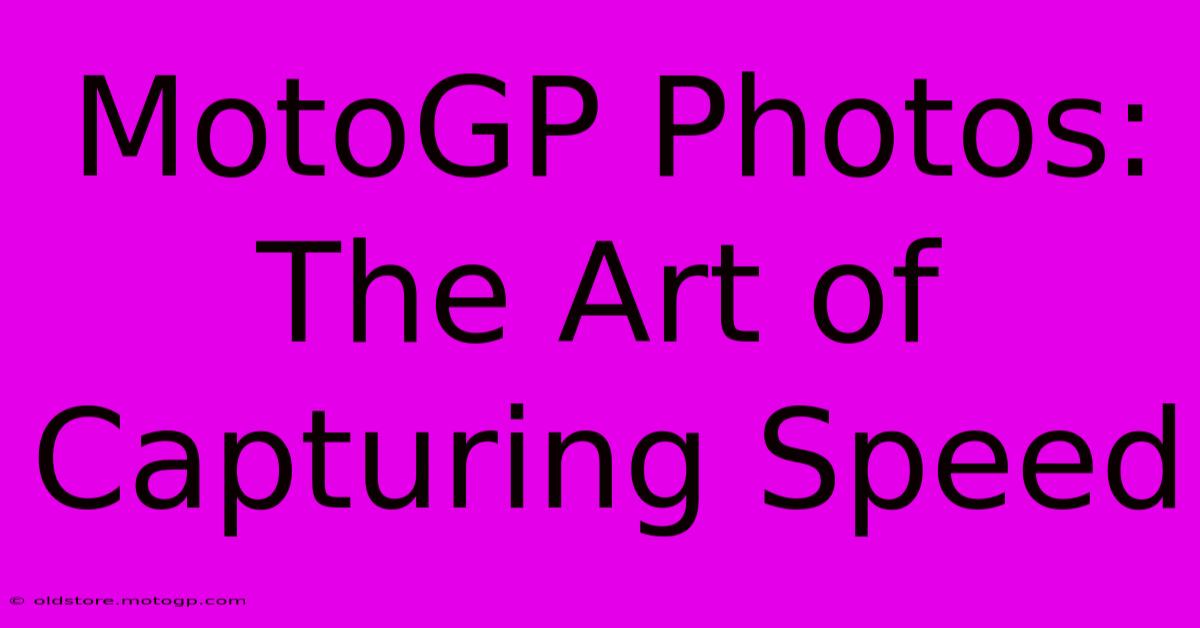MotoGP Photos: The Art Of Capturing Speed

Table of Contents
MotoGP Photos: The Art of Capturing Speed
MotoGP. The roar of engines, the blur of color, the breathtaking speed. It's a spectacle that demands to be witnessed, and for those who can't be trackside, photography offers the next best thing. But capturing the essence of MotoGP isn't just about pointing a camera and shooting; it's an art form requiring skill, precision, and a deep understanding of the sport. This article delves into the techniques and challenges of capturing stunning MotoGP photos.
The Challenges of Shooting MotoGP
Photographing MotoGP presents unique challenges. The sheer speed of the bikes makes capturing sharp, clear images incredibly difficult. A slight hesitation can mean a blurry mess instead of a dramatic shot. Other obstacles include:
- High Speed: The bikes can reach speeds exceeding 200 mph (320 km/h), requiring incredibly fast shutter speeds to freeze the action.
- Lighting Conditions: Track lighting, sunlight, and even shadows can dramatically affect exposure and image quality. Photographers need to constantly adjust their settings.
- Competition: Many photographers are vying for the same shots, creating a competitive environment. Finding unique angles and perspectives is crucial.
- Safety: The environment is inherently dangerous. Photographers must maintain a safe distance and be aware of their surroundings at all times.
Essential Gear for MotoGP Photography
To conquer these challenges, photographers need the right equipment:
- High-Speed Camera: A camera capable of shooting at high frame rates (at least 7 frames per second, ideally much higher) is essential for capturing sharp images of the bikes in motion. A professional DSLR or mirrorless camera is recommended.
- Fast Lenses: Fast lenses with wide apertures (e.g., f/2.8 or faster) are crucial for achieving shallow depth of field and capturing enough light in challenging conditions. A telephoto lens is also vital to get close-up shots of the bikes.
- High-Speed Memory Cards: You'll need memory cards with high read and write speeds to keep up with the rapid burst shooting needed.
- Tripod or Monopod: Although handheld shooting is sometimes necessary, a tripod or monopod can help stabilize your camera for sharper images, especially in low-light conditions.
Mastering the Techniques: Shutter Speed, Aperture, and ISO
The cornerstone of successful MotoGP photography lies in understanding the interplay of shutter speed, aperture, and ISO:
- Shutter Speed: This is arguably the most critical setting. You'll need extremely fast shutter speeds (1/2000th of a second or faster) to freeze the action and avoid motion blur. Experiment to find the optimal speed that balances sharpness and sufficient light.
- Aperture: A wide aperture (low f-number) will allow more light to enter the camera, useful in low-light conditions. It will also create a shallow depth of field, blurring the background and emphasizing the bike and rider.
- ISO: Keep your ISO as low as possible to minimize noise (grain) in your images. However, you may need to increase it in low-light situations, balancing noise against shutter speed and aperture.
Composition and Creativity in MotoGP Photography
Technical proficiency is only half the battle. Creating truly captivating MotoGP photos also requires artistic vision:
- Leading Lines: Utilize track lines, barriers, or even the direction of the bikes themselves to draw the viewer's eye into the image.
- Rule of Thirds: Instead of centering your subject, place it off-center according to the rule of thirds for a more dynamic composition.
- Unique Angles: Don't just shoot from the same spots as everyone else. Experiment with different angles and viewpoints to find unique perspectives.
- Capturing Emotion: Try to capture the emotion of the race – the intensity of the riders, the drama of overtaking maneuvers, or the jubilation of victory.
Beyond the Track: Editing and Sharing Your MotoGP Photos
Post-processing is an integral part of the process. Use editing software to enhance your images, adjusting contrast, sharpness, and color balance. Sharing your work online, perhaps through social media or a personal website, allows you to connect with other motorsport enthusiasts and showcase your skills.
MotoGP photography is a challenging yet rewarding pursuit. By mastering the techniques, understanding the challenges, and cultivating a creative eye, you can capture the raw energy and breathtaking speed of this exhilarating sport. So, grab your camera, head to the track (safely!), and start creating your own stunning MotoGP memories.

Thank you for visiting our website wich cover about MotoGP Photos: The Art Of Capturing Speed. We hope the information provided has been useful to you. Feel free to contact us if you have any questions or need further assistance. See you next time and dont miss to bookmark.
Featured Posts
-
Gp Results The Importance Of Early Detection
Feb 20, 2025
-
F1 Event Houston Celebrate Speed And Innovation
Feb 20, 2025
-
Desmosedici The Moto Gp Machine That Sets The Standard
Feb 20, 2025
-
Cota Gifts More Than Just Souvenirs
Feb 20, 2025
-
Honda Moto Gp Designed To Win
Feb 20, 2025
